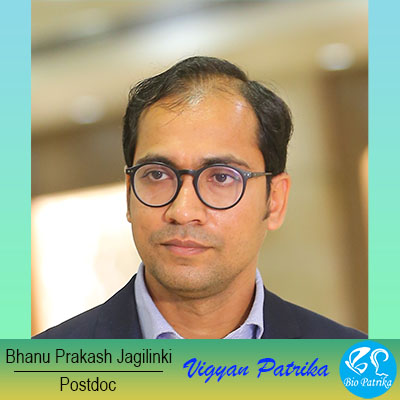Dr. Bhanu Prakash Jagilinki’s interview with Bio Patrika hosting “Vigyan Patrika”, a series of author interviews. Dr. Jagilinki is currently a Postdoctoral researcher under the guidance of Prof. Vikas Nanda and Prof. Paul Falkowski at Rutgers University, NJ, USA. Bhanu published a paper titled “In vivo biogenesis of a de novo designed iron-sulfur protein” as a first author in ACS Synthetic Biology (2020).
How would you explain your paper’s key results to the non-scientific community?
Ferredoxins are small iron-sulfur (FeS) containing metalloproteins, involved in several biological processes such as photosynthesis, respiration, nitrogen fixation and hydrogen metabolism. They are indispensable for all redox reactions as they mediate electron transfer between donors and acceptor proteins. The simplistic nature of these proteins had attracted several researchers worldwide in designing artificial FeS proteins. In the last few decades, several de novo FeS proteins have been successfully made. However, all these successful designs have been proven to exist or assemble only through chemical reconstitution (in vitro). The demonstration of these artificial proteins inside a biological system has thus far eluded. Our research shows that a designed coiled-coil iron−sulfur protein (CCIS) assembles robustly with FeS clusters inside bacteria (in vivo). This is the first report for a biological assembly of any artificially designed FeS protein.
“[…] first report for a biological assembly of any artificially designed FeS protein.”
What are the possible consequences of these findings for your research area?
The intent of metalloprotein design in making artificial FeS proteins has several implications for ‘bioelectronics’. For example, these artificial FeS proteins can be used to make ‘nano wires’ on a bio-chip to transfer electrons to active sites of energy converting enzymes like ‘Hydrogenase’ for making Hydrogen gas (figure 1), thus revolutionizing Green chemistry and providing clean energy to human society. These artificial FeS proteins can also be used to build artificial photosystems depending on their redox properties.

What was the exciting moment (eureka moment) during your research?
The most exciting part of my research is when we got excellent Mössbauer spectroscopy data, which pinpointed that the FeS clusters assembled in the CCIS protein as [4Fe-4S]. We got this exciting data in collaboration with the groups of Wolfgang Lubitz and James Birrell at MPI-CEC, Germany. Another equally exciting moment for me is, when we truncated the protein to 1/4th of its original size, it still assembles robustly with FeS clusters inside the bacteria. This truncated version is the smallest artificial protein to have a biological assembly of FeS clusters.
What do you hope to do next?
My next goal is to solve the structure of the truncated version of CCIS. Since the monomeric size of the protein is only about 25 amino acids, I am eagerly looking forward to getting the 3D structure. To solve this structure, we are using paramagnetic NMR, tailored to solve the structures of proteins with paramagnetic metal caters. I am also looking forward to working on some new designs/variants of CCIS/truncated-CCIS. The work for both the structural validation of truncated CCIS and the new designs has already been initiated. Also, I am writing research grants and looking forward to getting my research proposals funded.
Where do you seek scientific inspiration?
A constant urge to learn something new and develop novel ideas driven by robust hypothesises fuels my inspiration. Especially in the metalloprotein design field, there is a lot to explore and that keeps me motivated all-time in pursuit of some innovative ideas and (protein) designs. Mentors, colleagues and other researchers also inspire me through scientific discussions.
How do you intend to help Indian science improve?
I am not sure how I can help, but the Indian Science community is extremely strong and diverse with a lot of young talent. I would be delighted if any young researcher gets inspired by our work and motivated to do research in chemical biology.
Reference
Bhanu P. Jagilinki, Stefan Ilic, Cristian Trncik, Alexei M. Tyryshkin, Douglas H. Pike, Wolfgang Lubitz, Eckhard Bill, Oliver Einsle, James A. Birrell, Barak Akabayov, Dror Noy & Vikas Nanda. In vivo biogenesis of a de novo designed iron-sulfur protein. ACS Synthetic biology, 2020, Vol. 9, Issue No. 12, p. 3400 – 3007.
Author introduction and research interests
I received my Masters degree in Biochemistry from University of Hyderabad and received my Ph.D. form Tata Memorial Centre-Advanced Centre for Treatment, Research and Education in Cancer (TMC-ACTREC), Navi Mumbai. From there, I moved to Israel for my Postdoctoral research and from here, I was inclined to do research on metalloproteins and chemical biology. During my stay in Israel, I have acquired significant knowledge in characterizing metalloproteins using various biophysical techniques like CD, EPR, Mössbauer spectroscopy and electrochemistry. Later in 2019, I moved to Rutgers University, USA and continuing my research in the same field. Precisely, I am trying to understand the molecular origins of ‘Pre-biotic chemistry’ through de novo designed metalloproteins. I am hosting a virtual symposium on metalloproteins and chemical biology, titled, ‘Metalloproteins at the interface of design & nature, scheduled for 27th January 2021.” The speakers of this virtual symposium are going to cover a wide range of topics on metalloproteins involving several transition metals. This symposium is open for anyone who wants to attend it. Further details of the virtual symposium will be updated in the following website: https://bhanujagilinki.wixsite.com/research
Email: bhanu.jagilinki@rutgers.edu
